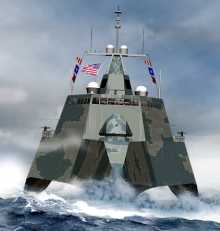Navy Develops Jet-Zipping Combat Ship
Sailor, these are not your father's warships. The first of a new breed of Navy ship - faster and easier to maneuver - is expected to launch later this year to meet threats including modern-day pirates and terrorists who turn speedboats into suicide weapons. The Littoral Combat Ship is powered by steerable water jets, so it doesn't need propellers or rudders. It's designed to go more than 50 mph; traditional destroyers have had the same top speed - about 35 mph - since World War II. The Littoral Combat Ship has a shallow draft, and its water jets let the ship zoom close to shore without getting stuck and to turn on a dime, allowing it to chase smaller boats. The name itself is taken from the coastal "littoral" waters in which the ship will operate. The ship will be more lightly armored than bigger ships, but its speed will give it a tactical advantage in combat, said Rear Adm. Charles Hamilton, program executive officer for ships, who's overseeing the project from Washington, D.C. The Navy envisions several of the ships working together on missions using unmanned vehicles, helicopters and other weapons, he said. A Littoral Combat Ship will have a core crew of only 40 sailors and berthing for up to 75, compared with 330 sailors aboard a destroyer. The new warship was conceived six years ago and fast-tracked after the USS Cole bombing and the terrorist attacks of Sept. 11, 2001. The first of the new ships will be delivered in roughly half the 10 to 15 years it takes under traditional shipbuilding programs. "That's a miracle in Navy terms," said Jay Korman, naval analyst at Washington consultants DFI Corporate Services. Two versions are under construction. Lockheed Martin Corp. is leading the team building LCS-1, with partners Marinette Marine Corp. in Wisconsin and Bollinger Shipyards Inc. in Louisiana. The Freedom ship due to launch this fall in Marinette, Wis., resembles a traditional frigate or destroyer but features a sleek, semiplaning hull, meaning the bow lifts at top speed, reducing resistance and making it faster. The other Littoral Combat Ship version by team leader Bath Iron Works, a subsidiary of General Dynamics Corp., resembles a futuristic catamaran. The aluminum "trimaran" Independence being built by Austal USA in Mobile, Ala., is loosely based on fast ferries developed in Australia.
The Navy envisions several of the ships working together on missions using unmanned vehicles, helicopters and other weapons, he said. A Littoral Combat Ship will have a core crew of only 40 sailors and berthing for up to 75, compared with 330 sailors aboard a destroyer. The new warship was conceived six years ago and fast-tracked after the USS Cole bombing and the terrorist attacks of Sept. 11, 2001. The first of the new ships will be delivered in roughly half the 10 to 15 years it takes under traditional shipbuilding programs. "That's a miracle in Navy terms," said Jay Korman, naval analyst at Washington consultants DFI Corporate Services. Two versions are under construction. Lockheed Martin Corp. is leading the team building LCS-1, with partners Marinette Marine Corp. in Wisconsin and Bollinger Shipyards Inc. in Louisiana. The Freedom ship due to launch this fall in Marinette, Wis., resembles a traditional frigate or destroyer but features a sleek, semiplaning hull, meaning the bow lifts at top speed, reducing resistance and making it faster. The other Littoral Combat Ship version by team leader Bath Iron Works, a subsidiary of General Dynamics Corp., resembles a futuristic catamaran. The aluminum "trimaran" Independence being built by Austal USA in Mobile, Ala., is loosely based on fast ferries developed in Australia. Lockheed Martin's version is 378 feet long, while General Dynamics' trimaran is 418 feet. By comparison, the typical Arleigh Burke-class destroyer is 510 feet long and the Zumwalt "stealth" destroyer being developed will be about 600 feet. The Navy plans to build 55 of one or both models of the Littoral Combat Ship to beef up a fleet that critics say was neglected even before the Iraq war. From nearly 600 ships in the 1980s, the fleet has dwindled to 289, a number the Navy wants to raise soon to 313. Instead of lengthy research and development, the Navy encouraged contractors to use off-the-shelf technologies from the private sector, much like the Army did as it rushed its Stryker vehicles into service in urban warfare in Iraq. The Navy also asked for ships that can be easily reconfigured for different missions. The resulting designs feature removable "mission packages" that allow the ships to operate either for anti-submarine missions, mine removal or traditional surface warfare, said Lt. Tamara Lawrence, a Navy spokeswoman at the Pentagon.
Lockheed Martin's version is 378 feet long, while General Dynamics' trimaran is 418 feet. By comparison, the typical Arleigh Burke-class destroyer is 510 feet long and the Zumwalt "stealth" destroyer being developed will be about 600 feet. The Navy plans to build 55 of one or both models of the Littoral Combat Ship to beef up a fleet that critics say was neglected even before the Iraq war. From nearly 600 ships in the 1980s, the fleet has dwindled to 289, a number the Navy wants to raise soon to 313. Instead of lengthy research and development, the Navy encouraged contractors to use off-the-shelf technologies from the private sector, much like the Army did as it rushed its Stryker vehicles into service in urban warfare in Iraq. The Navy also asked for ships that can be easily reconfigured for different missions. The resulting designs feature removable "mission packages" that allow the ships to operate either for anti-submarine missions, mine removal or traditional surface warfare, said Lt. Tamara Lawrence, a Navy spokeswoman at the Pentagon. Tests show the mission packages can be swapped out in 24 hours. And when those mission modules become outdated, the Navy can replace them instead of building new ships, Hamilton said. At about $350 million, a Littoral Combat Ship costs roughly a third as much as a destroyer, he said. While there's support for the faster craft, shipbuilders don't want the Navy to neglect bigger, multimission ships that project U.S. sea power around the world, said Cynthia Brown, president of the American Shipbuilding Association in Washington. The six shipyards that build the Navy's largest ships - aircraft carriers, amphibious assault ships, cruisers, destroyers and submarines - have lost 24,000 jobs since 1991, she said. Hamilton said the small shipyards were able to respond quickly to the Navy's needs on the Littoral Combat Ship and said the new warships could have a positive effect of bringing pressure to bear on the bigger, traditional shipyards like Bath Iron Works. Though Bath traditionally has built larger ships for the Navy, there's a lot of excitement about the Littoral Combat Ship, said Mike Keenan, president of the local machinists union in Bath. Bath Iron Works could eventually build some of the ships. "All in all, this could be a lucrative program where there could be a lot of work for a lot of shipbuilders," Keenan said.
Tests show the mission packages can be swapped out in 24 hours. And when those mission modules become outdated, the Navy can replace them instead of building new ships, Hamilton said. At about $350 million, a Littoral Combat Ship costs roughly a third as much as a destroyer, he said. While there's support for the faster craft, shipbuilders don't want the Navy to neglect bigger, multimission ships that project U.S. sea power around the world, said Cynthia Brown, president of the American Shipbuilding Association in Washington. The six shipyards that build the Navy's largest ships - aircraft carriers, amphibious assault ships, cruisers, destroyers and submarines - have lost 24,000 jobs since 1991, she said. Hamilton said the small shipyards were able to respond quickly to the Navy's needs on the Littoral Combat Ship and said the new warships could have a positive effect of bringing pressure to bear on the bigger, traditional shipyards like Bath Iron Works. Though Bath traditionally has built larger ships for the Navy, there's a lot of excitement about the Littoral Combat Ship, said Mike Keenan, president of the local machinists union in Bath. Bath Iron Works could eventually build some of the ships. "All in all, this could be a lucrative program where there could be a lot of work for a lot of shipbuilders," Keenan said.
 The Navy envisions several of the ships working together on missions using unmanned vehicles, helicopters and other weapons, he said. A Littoral Combat Ship will have a core crew of only 40 sailors and berthing for up to 75, compared with 330 sailors aboard a destroyer. The new warship was conceived six years ago and fast-tracked after the USS Cole bombing and the terrorist attacks of Sept. 11, 2001. The first of the new ships will be delivered in roughly half the 10 to 15 years it takes under traditional shipbuilding programs. "That's a miracle in Navy terms," said Jay Korman, naval analyst at Washington consultants DFI Corporate Services. Two versions are under construction. Lockheed Martin Corp. is leading the team building LCS-1, with partners Marinette Marine Corp. in Wisconsin and Bollinger Shipyards Inc. in Louisiana. The Freedom ship due to launch this fall in Marinette, Wis., resembles a traditional frigate or destroyer but features a sleek, semiplaning hull, meaning the bow lifts at top speed, reducing resistance and making it faster. The other Littoral Combat Ship version by team leader Bath Iron Works, a subsidiary of General Dynamics Corp., resembles a futuristic catamaran. The aluminum "trimaran" Independence being built by Austal USA in Mobile, Ala., is loosely based on fast ferries developed in Australia.
The Navy envisions several of the ships working together on missions using unmanned vehicles, helicopters and other weapons, he said. A Littoral Combat Ship will have a core crew of only 40 sailors and berthing for up to 75, compared with 330 sailors aboard a destroyer. The new warship was conceived six years ago and fast-tracked after the USS Cole bombing and the terrorist attacks of Sept. 11, 2001. The first of the new ships will be delivered in roughly half the 10 to 15 years it takes under traditional shipbuilding programs. "That's a miracle in Navy terms," said Jay Korman, naval analyst at Washington consultants DFI Corporate Services. Two versions are under construction. Lockheed Martin Corp. is leading the team building LCS-1, with partners Marinette Marine Corp. in Wisconsin and Bollinger Shipyards Inc. in Louisiana. The Freedom ship due to launch this fall in Marinette, Wis., resembles a traditional frigate or destroyer but features a sleek, semiplaning hull, meaning the bow lifts at top speed, reducing resistance and making it faster. The other Littoral Combat Ship version by team leader Bath Iron Works, a subsidiary of General Dynamics Corp., resembles a futuristic catamaran. The aluminum "trimaran" Independence being built by Austal USA in Mobile, Ala., is loosely based on fast ferries developed in Australia. Lockheed Martin's version is 378 feet long, while General Dynamics' trimaran is 418 feet. By comparison, the typical Arleigh Burke-class destroyer is 510 feet long and the Zumwalt "stealth" destroyer being developed will be about 600 feet. The Navy plans to build 55 of one or both models of the Littoral Combat Ship to beef up a fleet that critics say was neglected even before the Iraq war. From nearly 600 ships in the 1980s, the fleet has dwindled to 289, a number the Navy wants to raise soon to 313. Instead of lengthy research and development, the Navy encouraged contractors to use off-the-shelf technologies from the private sector, much like the Army did as it rushed its Stryker vehicles into service in urban warfare in Iraq. The Navy also asked for ships that can be easily reconfigured for different missions. The resulting designs feature removable "mission packages" that allow the ships to operate either for anti-submarine missions, mine removal or traditional surface warfare, said Lt. Tamara Lawrence, a Navy spokeswoman at the Pentagon.
Lockheed Martin's version is 378 feet long, while General Dynamics' trimaran is 418 feet. By comparison, the typical Arleigh Burke-class destroyer is 510 feet long and the Zumwalt "stealth" destroyer being developed will be about 600 feet. The Navy plans to build 55 of one or both models of the Littoral Combat Ship to beef up a fleet that critics say was neglected even before the Iraq war. From nearly 600 ships in the 1980s, the fleet has dwindled to 289, a number the Navy wants to raise soon to 313. Instead of lengthy research and development, the Navy encouraged contractors to use off-the-shelf technologies from the private sector, much like the Army did as it rushed its Stryker vehicles into service in urban warfare in Iraq. The Navy also asked for ships that can be easily reconfigured for different missions. The resulting designs feature removable "mission packages" that allow the ships to operate either for anti-submarine missions, mine removal or traditional surface warfare, said Lt. Tamara Lawrence, a Navy spokeswoman at the Pentagon. Tests show the mission packages can be swapped out in 24 hours. And when those mission modules become outdated, the Navy can replace them instead of building new ships, Hamilton said. At about $350 million, a Littoral Combat Ship costs roughly a third as much as a destroyer, he said. While there's support for the faster craft, shipbuilders don't want the Navy to neglect bigger, multimission ships that project U.S. sea power around the world, said Cynthia Brown, president of the American Shipbuilding Association in Washington. The six shipyards that build the Navy's largest ships - aircraft carriers, amphibious assault ships, cruisers, destroyers and submarines - have lost 24,000 jobs since 1991, she said. Hamilton said the small shipyards were able to respond quickly to the Navy's needs on the Littoral Combat Ship and said the new warships could have a positive effect of bringing pressure to bear on the bigger, traditional shipyards like Bath Iron Works. Though Bath traditionally has built larger ships for the Navy, there's a lot of excitement about the Littoral Combat Ship, said Mike Keenan, president of the local machinists union in Bath. Bath Iron Works could eventually build some of the ships. "All in all, this could be a lucrative program where there could be a lot of work for a lot of shipbuilders," Keenan said.
Tests show the mission packages can be swapped out in 24 hours. And when those mission modules become outdated, the Navy can replace them instead of building new ships, Hamilton said. At about $350 million, a Littoral Combat Ship costs roughly a third as much as a destroyer, he said. While there's support for the faster craft, shipbuilders don't want the Navy to neglect bigger, multimission ships that project U.S. sea power around the world, said Cynthia Brown, president of the American Shipbuilding Association in Washington. The six shipyards that build the Navy's largest ships - aircraft carriers, amphibious assault ships, cruisers, destroyers and submarines - have lost 24,000 jobs since 1991, she said. Hamilton said the small shipyards were able to respond quickly to the Navy's needs on the Littoral Combat Ship and said the new warships could have a positive effect of bringing pressure to bear on the bigger, traditional shipyards like Bath Iron Works. Though Bath traditionally has built larger ships for the Navy, there's a lot of excitement about the Littoral Combat Ship, said Mike Keenan, president of the local machinists union in Bath. Bath Iron Works could eventually build some of the ships. "All in all, this could be a lucrative program where there could be a lot of work for a lot of shipbuilders," Keenan said.



















<< Home